While the hustle and bustle of vintage is finally settling down, there is still plenty of important working going on in the winery. Rob is busy preparing his ‘babies’ for the next stage of their development (and no, he doesn’t have a favourite!).
Let’s take a look a closer look…
Sauvignon Blanc (in tank)
This wine has now been confirmed in the lab as “sugar dry”. That means that fermentation is complete. Therefore, it is now ready to “rack” (which will happen over the coming week) and a small amount of protective sulphur dioxide will be added.
Whoa… wait up! That’s a lot of technical terms to throw at you in one paragraph. Let’s just take a minute to look at these in more detail.
Sugar Dry: This just means that all of the fermentable sugars (being glucose and fructose) are below 1 g/L (or 0.1%). There comes a point in the fermentation that measuring the Baumé is no longer sensitive enough to determine the point when the fermentation has stopped, and the wine is considered dry. That is when the laboratory needs to use much more specific tests such as enzymatic assays or High Performance Liquid Chromatography (HPLC for short, because let’s face it, that’s a mouthful!).
Racking: racking a white wine simply means to move it from the tank it was fermented in (with all the lees and sediment at the bottom of it) to a fresh, clean vessel. Particularly with a wine like Sauvignon Blanc, you don’t want to leave it on this sediment for too long after the completion of fermentation as this starts to affect the taste of the finished wine.
Sulphur Dioxide (or SO2): Let’s come back to this.
Chardonnay (in barrel)
This wine is also dry, so Rob is happy to add the malolactic bacteria now. He’ll then give it a good stir and top up the barrels to ensure there is very little space at the very top. The more space, the more oxygen in the barrel which has the potential to cause oxidation.
If you missed the question on last week’s blog post about why Rob prefers to wait until the end of fermentation to add the MLF bacteria, then here is the answer…
“There’s a feeling that adding MLF bugs while the yeast fermentation is still finishing (and residual sugar still in the wine), may lead to acetic acid (VA) production. Since there’s no great rush to get MLF started, we’d prefer not to take that chance!”
Fumé Blanc (in barrel)
This is also dry and will now be treated in the same way as the Chardonnay
Pinot Rosé (in tank)
Again, this one has also finished fermentation and is considered dry. It’s also ready for some MLF bacteria to be added. Seeing this wine doesn’t spend any time in barrel, and the malolactic fermentation process will happen in a tank, Rob will need to transfer this to a tank that is just big enough for the volume of wine and then top it up to make sure the amount of space in the tank is at a minimum… just like the barrels for the Chardonnay and Fume.
Pinot Dry Red (in barrel)
The Pinot has been dry for a while now. At least one of the barrels has already finished malolactic fermentation. Rob will give it a couple more days before he gets the lab to take a representative sample of all of the individual barrels to check if all of the barrels have finished. If they have finished, then he’ll rack them and add a small amount of sulphur dioxide and top them up.
Racking a wine in barrel is essentially the same process as for wines in tank. The wine is siphoned off into a tank, the barrels are then cleaned out with a high pressure hose to remove all the sediment and residue and the wine is then returned to the barrels.
At this stage, the wines are really quite fragile. That’s why it is super important to keep oxygen away from the wines by ensuring the containers are absolutely full. This means periodically checking all the barrels and topping them up as necessary.
So, what’s the story with sulphur dioxide?
Without opening an enormous can of worms, let’s briefly have a chat about the role of SO2 in wine production.
Sulphur dioxide has been used in winemaking for many years. There is talk of the Egyptians and Romans using it, but there hasn’t been any conclusive proof of that.
Sulphur dioxide is a unique compound which inhibits microbial activity and aids in preventing oxidation and therefore is commonly used for maintaining the wine in prime condition.
It can be added to the bins in which the grapes are harvested and transported to the winery, to the juice prior to fermentation and, most commonly, to the wine after fermentation and during storage.
Sulphur dioxide is added in very small amounts and is considered harmless to most consumers. A small proportion of people can be sensitive to sulphur dioxide. In these cases though, it is important to remember that sulphur dioxide is actually naturally produced by yeast during the fermentation process. Therefore, some sulphur dioxide will be present in all wines even if it has not been added.
Do you have any questions or comments about adding sulphur to wine? We’d love to hear your thoughts.
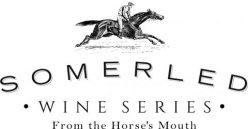
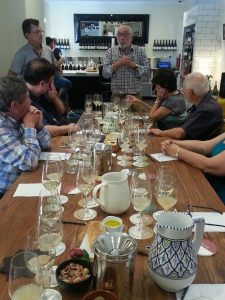
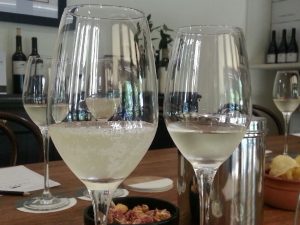 Sauvignon Blanc (ex-stainless steel tank): The aroma was at the tropical fruits end of the spectrum (think rockmelon and passionfruit). That’s because although the Adelaide Hills is classified as cool climate, Kim’s vineyard has an east facing aspect. The fruit takes on these attractive tropical flavours – rather than gooseberry, herbaceous notes. The young wine was still fizzy (see photo) as the ferment wasn’t complete at that stage, but not far off. This will be replaced with a crispness in the finished wine. As you can see, it was cloudy. Careful racking, fining and filtering will take care of that.
Sauvignon Blanc (ex-stainless steel tank): The aroma was at the tropical fruits end of the spectrum (think rockmelon and passionfruit). That’s because although the Adelaide Hills is classified as cool climate, Kim’s vineyard has an east facing aspect. The fruit takes on these attractive tropical flavours – rather than gooseberry, herbaceous notes. The young wine was still fizzy (see photo) as the ferment wasn’t complete at that stage, but not far off. This will be replaced with a crispness in the finished wine. As you can see, it was cloudy. Careful racking, fining and filtering will take care of that.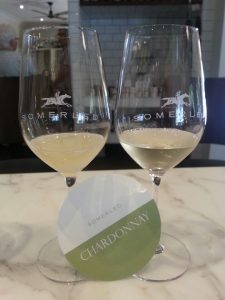 Chardonnay (ex-French oak barrels): Aromas of citrus (like grapefruit). It already exhibits its hallmark mouthfeel (think of that lovely creamy feeling you get with a good glass of chardy!) Its richness may be partly due to the bit of sugar which is still fermenting out. It’s certainly heading down the right track though.
Chardonnay (ex-French oak barrels): Aromas of citrus (like grapefruit). It already exhibits its hallmark mouthfeel (think of that lovely creamy feeling you get with a good glass of chardy!) Its richness may be partly due to the bit of sugar which is still fermenting out. It’s certainly heading down the right track though.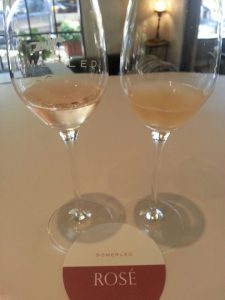 Rosé (ex-stainless steel tank): Looked like pink grapefruit juice, but had those lovely strawberry flavours we all love in this wine. It looked sweet compared with the 2017, but it will be quite dry by the time it gets to bottle.
Rosé (ex-stainless steel tank): Looked like pink grapefruit juice, but had those lovely strawberry flavours we all love in this wine. It looked sweet compared with the 2017, but it will be quite dry by the time it gets to bottle.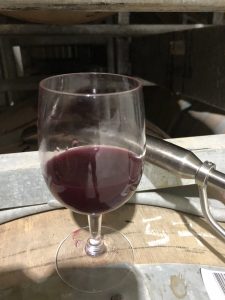
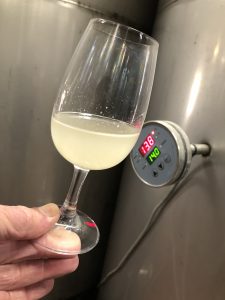 Our Sauvignon Blanc is about 70% through fermentation and is fabulously aromatic.
Our Sauvignon Blanc is about 70% through fermentation and is fabulously aromatic.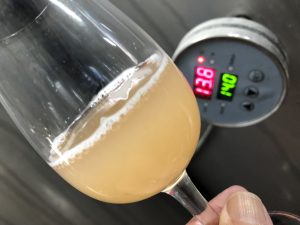 It is still very early days for the Chardonnay. You may remember that the Chardonnay started out cloudy like this – and yet last week if appeared crystal clear and golden! The grape solids had settled to the bottom, rendering it lovely and bright. Now it’s cloudy again – not because of grape solids this time, but because it is now chock full of yeast cells.
It is still very early days for the Chardonnay. You may remember that the Chardonnay started out cloudy like this – and yet last week if appeared crystal clear and golden! The grape solids had settled to the bottom, rendering it lovely and bright. Now it’s cloudy again – not because of grape solids this time, but because it is now chock full of yeast cells.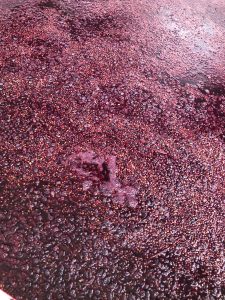
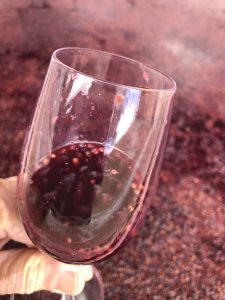 Pinot Noir for our dry red was
Pinot Noir for our dry red was 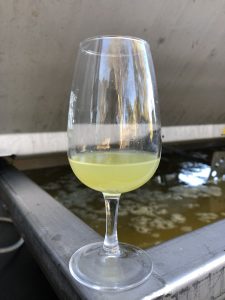
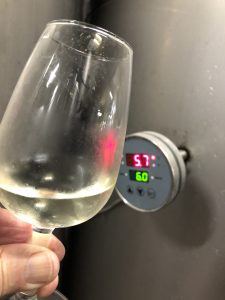
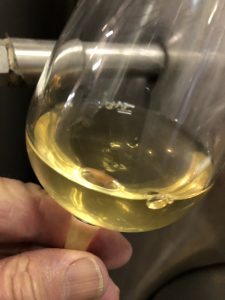
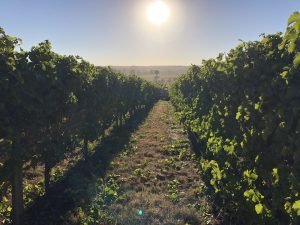
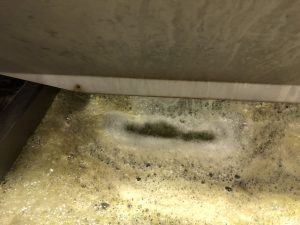
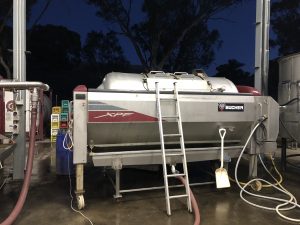
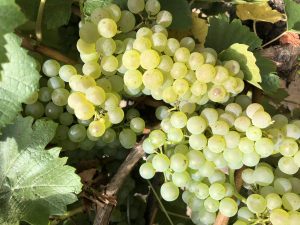
 However, that doesn’t mean that Rob puts his feet up and lets them take care of the bottling process. Nothing could be further from the truth! His day started at 8am yesterday when he went to check that the wine arrived safely and to ensure that there hasn’t been a mix up with any of the wines. He also checks that the carbon dioxide and dissolved oxygen levels are within specification. Despite all the care and attention, it’s a rather nerve-wracking time for Rob… it’s for this reason that he always leaves the wine for a week or two before tasting it after bottling. And there’s no doubt that the wine does change due to all the handling prior to and during bottling… but then it settles down and usually looks better after a while than it did before it was bottled.
However, that doesn’t mean that Rob puts his feet up and lets them take care of the bottling process. Nothing could be further from the truth! His day started at 8am yesterday when he went to check that the wine arrived safely and to ensure that there hasn’t been a mix up with any of the wines. He also checks that the carbon dioxide and dissolved oxygen levels are within specification. Despite all the care and attention, it’s a rather nerve-wracking time for Rob… it’s for this reason that he always leaves the wine for a week or two before tasting it after bottling. And there’s no doubt that the wine does change due to all the handling prior to and during bottling… but then it settles down and usually looks better after a while than it did before it was bottled.
 By the time the pinot was picked and pressed, the Baumé (take a look at last week’s
By the time the pinot was picked and pressed, the Baumé (take a look at last week’s  The pinot noir grapes (see picture) for our sparkling were last tested on Sunday, at which time the Baumé was 9.2. The previous test was on 19th Feb, and back then it was at 7.8. That’s an increase of 1.4 oBé in a week! Rob aims for a Baume of around 10 in the juice for the sparkling, so it’s not very far away at all. They’re being tested again tonight to confirm the decision to pick on Tuesday. Given Rob prefers the Baumé not to get too high, he can’t see that we will delay picking any longer than that.
The pinot noir grapes (see picture) for our sparkling were last tested on Sunday, at which time the Baumé was 9.2. The previous test was on 19th Feb, and back then it was at 7.8. That’s an increase of 1.4 oBé in a week! Rob aims for a Baume of around 10 in the juice for the sparkling, so it’s not very far away at all. They’re being tested again tonight to confirm the decision to pick on Tuesday. Given Rob prefers the Baumé not to get too high, he can’t see that we will delay picking any longer than that. The sauvignon blanc grapes are looking really lovely (see picture). Back on 22nd Feb, the Baumé was just under 10 and we’re currently waiting on lab results from a sample taken today. For this wine, Rob aims for a Baumé of 11.0 – 11.5, so Tuesday is looking like the day it will all happen!
The sauvignon blanc grapes are looking really lovely (see picture). Back on 22nd Feb, the Baumé was just under 10 and we’re currently waiting on lab results from a sample taken today. For this wine, Rob aims for a Baumé of 11.0 – 11.5, so Tuesday is looking like the day it will all happen! That said, there is still plenty happening…
That said, there is still plenty happening…